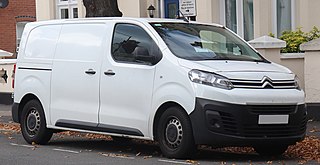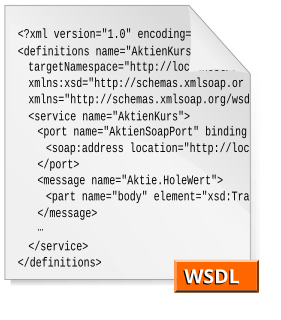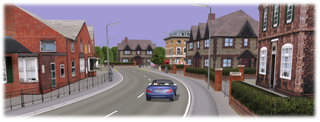 | |
| Filename extension | .rnd |
|---|---|
| Latest release | 3.0.0 |
| Type of format | Road Network Description |
| Extended from | XML |
| Open format? | Yes |
| Website | road-xml.org |
RoadXML is an open file format for the road networks description used by driving simulators.
 | |
| Filename extension | .rnd |
|---|---|
| Latest release | 3.0.0 |
| Type of format | Road Network Description |
| Extended from | XML |
| Open format? | Yes |
| Website | road-xml.org |
RoadXML is an open file format for the road networks description used by driving simulators.
RoadXML was initiated to contribute to road network format standardization in order to enhance the interoperability between simulators. [1] It is the outcome of the compilation of several original formats (GRS, RNS/RS, RND) developed in 1994 by academic and industrial partners: INRETS, Oktal, PSA Peugeot Citroën, Renault, Thales.
RoadXML offers a multi layer description of the environment for fast data access for real time applications. Here are the four main layers of information:
Until its 2.0 version, RoadXML was called RND (for Road Network Description):
Since the version 2.1, an open source parser for RoadXML is also available on SourceForge.

Extensible Markup Language (XML) is a markup language and file format for storing, transmitting, and reconstructing arbitrary data. It defines a set of rules for encoding documents in a format that is both human-readable and machine-readable. The World Wide Web Consortium's XML 1.0 Specification of 1998 and several other related specifications—all of them free open standards—define XML.
In computing, RELAX NG is a schema language for XML—a RELAX NG schema specifies a pattern for the structure and content of an XML document. A RELAX NG schema is itself an XML document but RELAX NG also offers a popular compact, non-XML syntax. Compared to other XML schema languages RELAX NG is considered relatively simple.

The Peugeot 307 is a small family car produced by the French automaker PSA Peugeot Citroën, under their Peugeot marque, from 2001 to 2008 in Europe, and was the successor to the Peugeot 306, which was discontinued in 2002 after being in production for nine years. It was awarded the European Car of the Year title for 2002, and continued to be offered in China and certain South American markets through 2014, despite the French launch of the 308 in September 2007.

The Peugeot 407 is a large family car (D-segment) produced by the French automaker Peugeot, from 2003 to 2010. It was available in saloon, coupé and estate variants, with both diesel and petrol engines. The petrol engines ranged from 1.8 to 3.0 litres displacement, whereas the diesels ranged from 1.6 to 3.0 litre engines.
MusicXML is an XML-based file format for representing Western musical notation. The format is open, fully documented, and can be freely used under the W3C Community Final Specification Agreement.

The PSA Group, legally known as Peugeot S.A., was a French multinational automotive manufacturing company which produced automobiles and motorcycles under the Peugeot, Citroën, DS, Opel and Vauxhall brands. On 18 December 2019, PSA and Fiat Chrysler Automobiles announced that they had agreed to the terms of a binding $50 billion merger. On 16 July 2020, both companies announced the new name for their merged operations, Stellantis. The deal closed on 16 January 2021.
COLLADA is an interchange file format for interactive 3D applications. It is managed by the nonprofit technology consortium, the Khronos Group, and has been adopted by ISO as a publicly available specification, ISO/PAS 17506.

The Citroën Jumpy is a light commercial van originally developed by the Sevel subdivision of Stellantis under the Fiat, Peugeot and Citroën brands, produced since 1994. The Jumpy was also sold as the Peugeot Expert and Fiat Scudo beginning in 1995.
The Extensible Metadata Platform (XMP) is an ISO standard, originally created by Adobe Systems Inc., for the creation, processing and interchange of standardized and custom metadata for digital documents and data sets.
Office Open XML is a zipped, XML-based file format developed by Microsoft for representing spreadsheets, charts, presentations and word processing documents. The format was initially standardized by the Ecma, and by the ISO and IEC in later versions.

The PSA X engine is a family of internal combustion engines used in Citroën, Peugeot, Talbot and Renault automobiles. The X family was mainly used in superminis and the entry level models of midsize vehicles. It was designed and manufactured by the company "Française de Mécanique", a joint venture created by Peugeot and Renault in 1969, and built in Douvrin in northern France. It is commonly called the "Suitcase" engine, the "Douvrin" nickname being commonly given to the bigger 2.0-2.2 L J-Type engine, which was also built in Douvrin.
XLIFF is an XML-based bitext format created to standardize the way localizable data are passed between and among tools during a localization process and a common format for CAT tool exchange. The XLIFF Technical Committee (TC) first convened at OASIS in December 2001, but the first fully ratified version of XLIFF appeared as XLIFF Version 1.2 in February 2008. Its current specification is v2.1 released on 2018-02-13, which is backwards compatible with v2.0 released on 2014-08-05.
Efficient XML Interchange (EXI) is a binary XML format for exchange of data on a computer network. It was developed by the W3C's Efficient Extensible Interchange Working Group and is one of the most prominent efforts to encode XML documents in a binary data format, rather than plain text. Using EXI format reduces the verbosity of XML documents as well as the cost of parsing. Improvements in the performance of writing (generating) content depends on the speed of the medium being written to, the methods and quality of actual implementations. EXI is useful for

EPUB is an e-book file format that uses the ".epub" file extension. The term is short for electronic publication and is sometimes styled ePub. EPUB is supported by many e-readers, and compatible software is available for most smartphones, tablets, and computers. EPUB is a technical standard published by the International Digital Publishing Forum (IDPF). It became an official standard of the IDPF in September 2007, superseding the older Open eBook standard.

The Web Services Description Language is an XML-based interface description language that is used for describing the functionality offered by a web service. The acronym is also used for any specific WSDL description of a web service, which provides a machine-readable description of how the service can be called, what parameters it expects, and what data structures it returns. Therefore, its purpose is roughly similar to that of a type signature in a programming language.

OpenDRIVE is an open format specification to describe a road network's logic. Its objective is to standardize the logical road description to facilitate the data exchange between different driving simulators.
Data Format Description Language, published as an Open Grid Forum Proposed Recommendation in January 2011, is a modeling language for describing general text and binary data in a standard way. A DFDL model or schema allows any text or binary data to be read from its native format and to be presented as an instance of an information set.. The same DFDL schema also allows data to be taken from an instance of an information set and written out to its native format.
France was a pioneer in the automotive industry and is the 11th-largest automobile manufacturer in the world by 2015 unit production and the third-largest in Europe. It had consistently been the 4th-largest from the end of World War II up to 2000.
Andras Kemeny, born on July 14, 1952, is a French engineer and researcher, and President of the Driving Simulation Association. He is Director of the Laboratory of Immersive Visualization (LIV) ENSAM-Renault from its creation in January 2011 until 2021, Scientific Director of A.V. Simulation, a company specialized in simulation, editor of the Scaner Studio © software and common subsidiary of Oktal and Renault companies, from its creation in July 2017 until March 2019. He is now the President of its Scientific Board, and the entry of Dassault Systèmes into the capital of A.V. Simulation has been announced in January 2021. He also is Expert-leader in Immersive Simulation and Virtual Reality for Renault and Associate Professor at Arts et métiers. He is one of the main actors in the virtual reality and driving simulation fields in France and in Europe.

The PSA ES/L engine is a V6 engine used in automotive applications. It was co-developed by the PSA Group and Renault to replace the outdated V6 PRV engine. It was introduced in 1997 with the Peugeot 406 Coupé. It is designed and manufactured by the company "Française de Mécanique" for PSA and Renault. In PSA, the engine is known as the ES engine, in Renaults, the engine is known as the L engine.